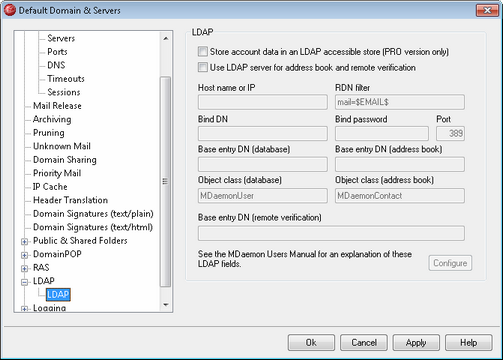
LDAP
Store account data in an LDAP accessible store (PRO version only)
Click this check box if you want MDaemon to use your LDAP server as the MDaemon user database rather than ODBC or its local USERLIST.DAT system. You might want to use this method of maintaining your user information if you have multiple MDaemon servers at different locations but want them to share a single user database. Each MDaemon server would be configured to connect to the same LDAP server in order to share user information rather than storing it locally.
Use LDAP server for address book and remote verification
If you are using ODBC or the default USERLIST.DAT method of maintaining your account database rather than the LDAP server method, you can still keep an LDAP server up to date with all of your users' names, email addresses, and aliases by enabling this checkbox. Thus, you can still keep an LDAP server up to date for use as a global address book system for users of email clients that contain support for LDAP address books.
This will maintain a database of your mailboxes, aliases, and mailing lists that your remote backup servers can query for remote verification of address information. See Base entry DN (remote verification) below for more information.
LDAP Server Properties
Host name or IP
Enter the host name or IP address of your LDAP server here.
RDN filter
This control is used to generate the RDN for each user's LDAP entry. The relative distinguished name (RDN) is the leftmost component in each entry's distinguished name (DN). For all peer entries (those sharing a common immediate parent) the RDN must be unique, therefore we suggest using each user's email address as their RDN to avoid possible conflicts. Using the $EMAIL$ macro as the value of the attribute in this control (i.e. mail=$EMAIL$) will cause it to be replaced by the user's email address when their LDAP entry is created. The user's DN will be comprised of the RDN plus the Base entry DN below.
Bind DN
Enter the DN of the entry to which you have granted administrative access to your LDAP server so that MDaemon can add and modify your MDaemon user entries. This is the DN used for authentication in the bind operation.
Bind Password
This password will be passed to your LDAP server along with the Bind DN value for authentication.
Port
Specify the port that your LDAP server is monitoring. MDaemon will use this port when posting account information to it.
Base entry DN (database)
Enter the base entry (root DN) that will be used in all of your MDaemon user entries when you are using the LDAP server as your user database rather than the USERLIST.DAT file. The Base entry DN is combined with the RDN (see RDN filter above) to make up each user's distinguished name (DN).
Base entry DN (address book)
When mirroring account information to an LDAP database address book, enter the base entry (root DN) that will be used in all of your MDaemon user address book entries. The Base entry DN is combined with the RDN (see RDN filter above) to make up each user's distinguished name (DN).
Object class (database)
Specify the object class to which each MDaemon user's user database entry must belong. Each entry will contain the objectclass= attribute with this as its value.
Object class (address book)
Specify the object class to which each MDaemon user's LDAP address book entry must belong. Each entry will contain the objectclass= attribute with this as its value.
Base entry DN (remote verification)
One common problem with domain gateways and backup servers is that they don't usually have a method for determining whether or not the recipient of an incoming message is valid. For instance, if a message comes to example.com's backup server for user1@example.com then the backup server has no way of knowing whether or not there is actually a mailbox, alias, or mailing list at example.com for "user1". Thus the backup server has no choice but to accept all of the messages. MDaemon contains a method for verifying these addresses and solving this problem. By specifying a Base entry DN that will be used for all mailboxes, aliases, and mailing lists, your LDAP server can be kept up to date with all of this information. Then, your backup server can simply query your LDAP server each time a message arrives for your domain and verify whether or not the recipient's address is valid. If it isn't then the message will be rejected.
Configure
Click this button to open the LDAP.dat configuration file in a text editor. It is used for designating the LDAP attribute names that will correspond to each MDaemon account field.
See: